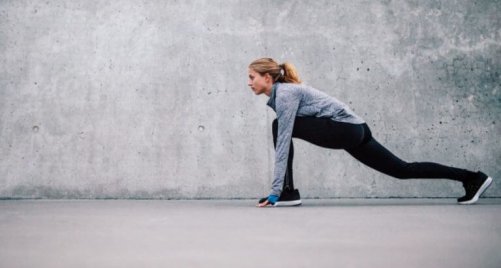Do You Feel Pain When Stretching?

The number of people who are starting to exercise for health reasons is constantly increasing. And, this is evident by just looking at the groups of people at the park exercising on a nice day. However, not everyone understands the importance of stretching or realizes that you shouldn’t feel any pain when stretching.
Most athletes know how essential it is to stretch for at least 10 minutes. However, most of them decide to ignore it, and so, it becomes one of the main causes of injury.
It’s not just about the time it takes you to stretch, it’s also important to do so well and safely. There are certain rules to know when and how to stretch. One of the most important principles in these exercises is the pain factor.
Therefore, If you’re feeling pain when stretching, then you’re doing it wrong!
Here, we will examine the correct way to perform a routine without feeling pain when stretching.
The importance of stretching
A complete workout should always include a stretching routine and this practice will help you avoid injuries. And so, anywhere between 5 to 10 minutes will benefit your body immensely.
Stretching after an intense workout helps the muscles recover more easily and quickly. Likewise, it will avoid intense soreness for the following days. When stretching you should feel a slight tension on that part of the body. You should never feel pain when stretching.
On the other hand, these types of exercises will help you improve your flexibility, thus reducing the risk of injuries. When the muscle becomes rigid and tense, it has higher odds of tearing. But, with the other extreme, when the muscle is flexible, it will be more difficult for it to tear.

When should we stretch?
There is no consensus on when we should stretch, whether before, or after a workout. Some people may even argue that working out after stretching may make your muscles more prone to injuries.
Therefore, the consensus is more about the type of stretching you do, rather than when you do it. Professionals recommend avoiding static stretching before an intense workout routine. Therefore, the ideal stretching exercises are dynamic, active and ones that are combined with joint movements.
As for stretching after a workout, most experts agree that it’s necessary and it benefits the muscle health. However, it’s important to remember that the feeling should be more of tension in the muscles than pain when stretching.
After working out, the muscles are warmer and if we stretch we will help them recover elasticity. At that moment the muscle suffers microstructures and stretching will help release lactic acid. Additionally, stretching will also help your tendons and joints.

You should feel no pain when stretching, only tension
Stretching exercises should include all of the muscle groups, not just the legs, as is common to see. Likewise, you should stretch carefully to avoid injuries. Thus, concentration and breathing are imperative here.
Don’t force the exercises to the point of feeling pain when stretching, you should only feel the muscles tense up. If you do feel pain when stretching, you’re doing something wrong and need to stop immediately.
To make the stretching exercises more efficient, it’s better to hold them for at least 25 to 30 seconds. After a workout, the exercises should be static. In other words, exercises that maintain a position, without bouncing. Deep breathing is key here, as well as concentration to determine if you feel pain when stretching.
In conclusion, a good stretching routine will help you recover from an intense workout more easily and quickly. Additionally, it will help you become more flexible and avoid injuries. However, remember that there should be no pain when stretching.
The number of people who are starting to exercise for health reasons is constantly increasing. And, this is evident by just looking at the groups of people at the park exercising on a nice day. However, not everyone understands the importance of stretching or realizes that you shouldn’t feel any pain when stretching.
Most athletes know how essential it is to stretch for at least 10 minutes. However, most of them decide to ignore it, and so, it becomes one of the main causes of injury.
It’s not just about the time it takes you to stretch, it’s also important to do so well and safely. There are certain rules to know when and how to stretch. One of the most important principles in these exercises is the pain factor.
Therefore, If you’re feeling pain when stretching, then you’re doing it wrong!
Here, we will examine the correct way to perform a routine without feeling pain when stretching.
The importance of stretching
A complete workout should always include a stretching routine and this practice will help you avoid injuries. And so, anywhere between 5 to 10 minutes will benefit your body immensely.
Stretching after an intense workout helps the muscles recover more easily and quickly. Likewise, it will avoid intense soreness for the following days. When stretching you should feel a slight tension on that part of the body. You should never feel pain when stretching.
On the other hand, these types of exercises will help you improve your flexibility, thus reducing the risk of injuries. When the muscle becomes rigid and tense, it has higher odds of tearing. But, with the other extreme, when the muscle is flexible, it will be more difficult for it to tear.

When should we stretch?
There is no consensus on when we should stretch, whether before, or after a workout. Some people may even argue that working out after stretching may make your muscles more prone to injuries.
Therefore, the consensus is more about the type of stretching you do, rather than when you do it. Professionals recommend avoiding static stretching before an intense workout routine. Therefore, the ideal stretching exercises are dynamic, active and ones that are combined with joint movements.
As for stretching after a workout, most experts agree that it’s necessary and it benefits the muscle health. However, it’s important to remember that the feeling should be more of tension in the muscles than pain when stretching.
After working out, the muscles are warmer and if we stretch we will help them recover elasticity. At that moment the muscle suffers microstructures and stretching will help release lactic acid. Additionally, stretching will also help your tendons and joints.

You should feel no pain when stretching, only tension
Stretching exercises should include all of the muscle groups, not just the legs, as is common to see. Likewise, you should stretch carefully to avoid injuries. Thus, concentration and breathing are imperative here.
Don’t force the exercises to the point of feeling pain when stretching, you should only feel the muscles tense up. If you do feel pain when stretching, you’re doing something wrong and need to stop immediately.
To make the stretching exercises more efficient, it’s better to hold them for at least 25 to 30 seconds. After a workout, the exercises should be static. In other words, exercises that maintain a position, without bouncing. Deep breathing is key here, as well as concentration to determine if you feel pain when stretching.
In conclusion, a good stretching routine will help you recover from an intense workout more easily and quickly. Additionally, it will help you become more flexible and avoid injuries. However, remember that there should be no pain when stretching.
All cited sources were thoroughly reviewed by our team to ensure their quality, reliability, currency, and validity. The bibliography of this article was considered reliable and of academic or scientific accuracy.
- Ayala, F., De Baranda, P. S., & Cejudo, A. (2012). El entrenamiento de la flexibilidad: Técnicas de estiramiento. Revista Andaluza de Medicina Del Deporte. Elsevier Doyma. https://doi.org/10.1016/S1888-7546(12)70016-3
- Arajol, L. P., José, J., & Tirado, G. (2010). Sobre la aplicación de estiramientos en el deportista sano y lesionado. Apunts Med Esport, 45(166), 109–125. https://doi.org/10.1593/neo.81384
This text is provided for informational purposes only and does not replace consultation with a professional. If in doubt, consult your specialist.








